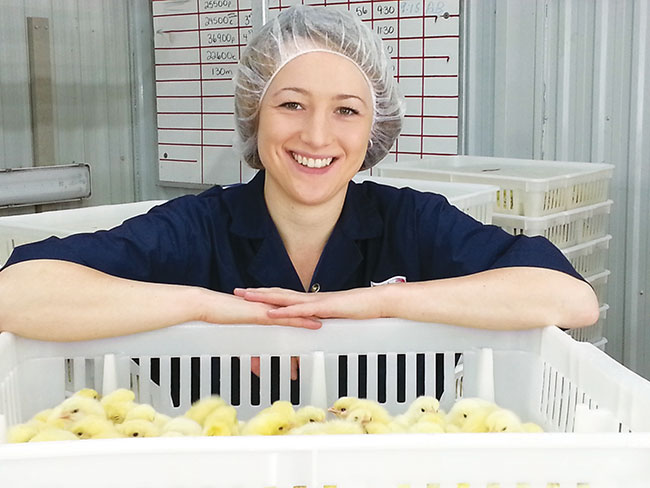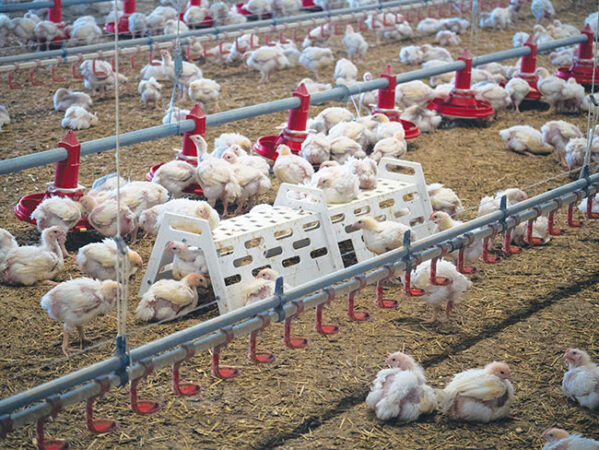
Broiler welfare evolving with science
By Treena Hein
Features WelfareMaple Leaf Foods expert shares insights into how broiler welfare has changed and where we need to go.
 Dr. Kathleen Long, vice president of animal care at Maple Leaf Foods, presented on broiler welfare at the recent Canadian Poultry Research Forum.
Dr. Kathleen Long, vice president of animal care at Maple Leaf Foods, presented on broiler welfare at the recent Canadian Poultry Research Forum.
Lighting, stocking density, enrichments, genetics – these are the main welfare concerns the Canadian broiler industry is discussing these days. What does the science show us and what standards are experts deliberating across the chicken industry?
We caught up with poultry veterinarian Dr. Kathleen Long, vice president of animal care at Maple Leaf Foods, to discuss. Long recently presented on broiler welfare at the Canadian Poultry Research Forum.
She explains that interest in animal welfare is still strong and various sets of standards, both created by industry and from external sources, are garnering a lot of attention.
She and her colleagues at Maple Leaf are among the many who believe industry must engage in standards discussions from a position of science-backed credibility, comprehensive understanding of what standards entail, transparency, continuous improvement and a big picture perspective.
For example, over 200 companies have signed a set of standards called the Better Chicken Commitment. But Long notes that leaders at some of these firms don’t fully understand what they have agreed to.
“There is a set of requirements to be met by 2024 and another for 2026, which includes the use of slow-growing broiler breeds,” she explains. “At this point, we at Maple Leaf Foods have committed that some of our supply will meet the 2024 requirements. There are quite a few food service, retail and restaurant firms that have signed onto the 2026 requirements but production firms have largely not done this. I believe that there is a lot of learning that will occur in terms of what slow-growth production entails.”
Long notes that the rate of updates over the last few years to standards from sources external to the broiler industry have been rapid and challenging for industry to address. “There are perhaps perceptions that industry-led national farm animal care programs aren’t keeping up, but there is also great opportunity here for transparency, to share what we are doing and the science behind the standards we follow,” she says.
“We believe strongly at Maple Leaf that if you didn’t report it, you didn’t do it. We get frequent survey inquiries from retailers, food service and restaurants asking how we are meeting, or will meet, various welfare standards that have been created. We put a huge amount of time into answering each one thoroughly. A lot of that relates to farm-level practices. These surveys are a great way to build trust and provide transparency.”
Maple Leaf Foods has also taken steps to gather and publicly release a large amount of detailed information about welfare practices, which includes an annual Sustainability Report and its Animal Care Performance Report. Also, this year, following its review of 150 companies in 25 countries, the Business Benchmark on Farm Animal Welfare, the leading global measure of policy commitment, performance and disclosure, ranked Maple Leaf Foods in Tier 2 among 11 other firms, with only four in Tier 1. Maple Leaf believes private companies and industry associations should share detailed information with the public.
Canada’s position
Long notes that Canada has a great history of progress with animal care and welfare.
“The National Farm Animal Care Council (NFACC) Codes of Practice are something to be proud of,” she says. “They are very robust and are backed by a large amount of scientific data. There is some discussion going forward that there should be tiered standards, and the NFACC Codes have requirements and also recommendations, so they are already tiered in a sense. Globally, we also have organic industry standards and special industry standards like raised without antibiotics. And another example is the Red Tractor program in the U.K., which has conventional farming standards, indoor higher welfare standards and free-range standards.”
Long notes that in Canada, some believe tiered standards are a way to avoid overburdening industry and move forward effectively with animal welfare. That said, some have concerns about the economic and environmental impacts of trying to meet the potential upper tier of any new standards and feel Canada has strong, unified standards already. “And we must remember that the NFACC Codes are reviewed every five years (which can trigger an update) and fully updated every 10 years,” she says, “and it is a very detailed process that examines all new research findings.”
Indeed, continuous improvement of national codes and updated on-farm practices are critical to maintain industry credibility, says Long. “We need research findings behind the creation of standards and validation that practices related to standards actually address welfare outcomes in commercial settings,” she says. “There is a lot of opportunity to improve industry understanding of what are the most important outcomes for broilers and other types of poultry and how to implement them in practical ways.”
Long believes that this approach provides industry a position of strength to defend against ill-advised standards that risk bird health, standards that do not actually improve bird welfare and those that are environmentally and financially unsustainable.

Long says birds love interacting with enrichments, even simple ones like the stool pictured here in an Ontario barn.
PHOTO CREDIT: Maple Leaf Foods
Four welfare areas
Long says there are four aspects of broiler farm level welfare that are of high interest to stakeholders, some of which require more study, consensus or broader implementation. One of these is stocking density. Broilers in Canada are kept at 31 kilograms per m2 or up to 38 if additional requirements are met. “Density is a very important focus for customers and animal welfare groups,” Long says. “We get inquiries on this all the time. In 2021, 69 per cent of birds supplying our primary processing operations were kept at 31 kilograms per m2 or less.”
Use of enrichments is the second major aspect. “The broiler NFACC Code is behind layer and pig codes in terms of enrichments and we are trying to advance that with our farmers,” Long says. “With our enrichments, we are seeing a lot of benefits for the birds and our farmers are noticing also and love seeing the birds interact with the enrichments.”
There is also inconsistency with the findings on lighting in broiler barns. “There is a great range of conclusions about light intensity, newer technologies like gradient lighting and varying colour spectra, and a lot of focus on natural light in different countries, which also has worker benefit,” Long says. “The topic is not understood well enough yet for changes to be implemented by industry. We are tentatively planning a research trial in 2023 in collaboration with researchers at University of Saskatchewan.”
Slow-growing breeds is the fourth and the most impactful broiler welfare aspect, Long says, one that is not yet well understood with regards to welfare. “There are findings that some aspects of welfare are improved with these breeds, and we cannot ignore those findings, but slower growth rates have an enormous negative environmental impact because much more feed, barn space and water is required,” Long says.
“We’ve done a number of trials using different breeds and learned a lot through a very in-depth analysis of welfare, sustainability and production efficiency. We must remember that the genetics of conventional birds in terms of certain historical welfare problems, such as leg strength, have undergone so much progress. I would say those issues have been largely addressed and were a main reason why slower-growing breeds were promoted in the first place.”
Long notes that there is a lot of focus on behaviour in the research as slow-growing breeds behave differently than conventional. “We also must remember that welfare outcomes depend on many factors besides breed, such as production practices and barn environment.” she says, “and that we are making steady progress on those fronts with conventional birds.”
Opportunities
Barn environment monitoring has never been better due to new technologies, and control has never been more precise, which provides many opportunities to optimize bird welfare.
Long says that “as a vet, it makes me very excited that if we can detect that a flock is dealing with a disease before we see signs of it in other ways, we can take proactive measures. We can also use historical data and also do predictive modelling for health and welfare outcomes. It’s a huge shift that is starting and there is no one consolidated way of doing things in the industry yet, but those will be developed. We will find ways to use all the measurements we can now obtain.”
In terms of other technologies, Maple Leaf is gathering data from automated scoring of foot pads (a welfare indicator) at processing to determine if there are differences in flocks and barns and why.
Moving forward
Long notes that Canada’s poultry welfare research programs at various universities are known worldwide but the challenge remains to translate research results into commercial practice standards.
She also notes that there is still debate on which welfare outcomes are most important. But the industry is moving from prescriptive outcomes such as cage size to things like foot pad scores that expose differences in bird health that are, in turn, affected by feeding program, barn conditions, management practices, genetics and more.
“The International Poultry Welfare Alliance has been doing a lot of work to come up with new welfare outcome measures recently and they are going for public consultation soon,” Long says. “I have been involved in these working groups and I hope the outcomes will be adopted globally. For broilers, they include gait mobility scoring, catching and transportation-related injuries and mortality.”
Print this page